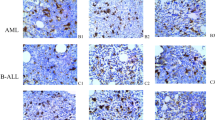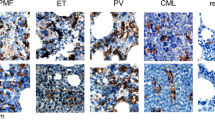Abstract
A morphometric and immunohistochemical study was performed on 354 bone marrow trephine biopsies derived from 126 patients with chronic myeloid leukaemia (CML) before and after allogeneic bone marrow transplantation (BMT). The purpose of this investigation was to evaluate the macrophage population, including several subsets and their dynamics in the posttransplant period. In addition to the total CD68+ resident (mature) macrophages the so-called activated fraction identified by its capacity to express α-d-galactosyl residues, the pseudo-Gaucher cells (PGCs) and the iron-laden histiocytic reticular cells were also considered. Following immuno- and lectin-histochemical staining morphometric analysis was carried out on sequential postgraft bone marrow specimens at standardized intervals. Compared to the normal bone marrow and calculated per haematopoiesis (cellularity) an overall decrease of about 40–50% in the quantity of CD68+ macrophages and the BSA-I+ subpopulation was detectable in the early posttransplant period (9–45 days after BMT). Noteworthy was the temporal recurrence of PGCs in the engrafted bone marrow, which was not associated with a clonally transformed cell population or leukaemic relapse. Reappearance of postgraft PGCs was most prominent in the first 2 months after BMT. This conspicuous feature was presumed to be functionally associated with a pronounced degradation of cell debris following pretransplant myelo-ablative therapy (scavenger macrophages). Evidence for an activation of the BSA-I+ macrophage subset was derived from the identical carbohydrate-binding capacity shown by the PGCs. In the regenerating haematopoiesis shortly after BMT a significant correlation between the number of BSA-I+ macrophages and erythroid precursor cells was determinable. This result implicates a close functional relationship between postgraft reconstitution of erythropoietic islets and centrally localized activated macrophages. In conclusion, findings emerging from this study included the reappearance of PCGs in the engrafted bone marrow independently of a leukaemic relapse and the significant association of the activated BSA-I+ macrophage subset with the recovery of erythropoiesis.
Similar content being viewed by others
Author information
Authors and Affiliations
Additional information
Received: 31 January 2000 / Accepted: 6 March 2000
Rights and permissions
About this article
Cite this article
Thiele, J., Kvasnicka, H., Beelen, D. et al. Macrophages and their subpopulations following allogeneic bone marrow transplantation for chronic myeloid leukaemia. Virchows Archiv 437, 160–166 (2000). https://doi.org/10.1007/s004280000224
Issue Date:
DOI: https://doi.org/10.1007/s004280000224




